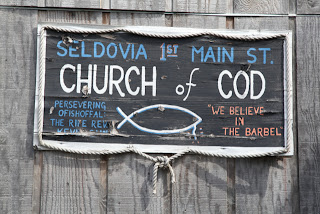Being Alaskan - fish’n’, hunt’n’ and camp’n’
 |
| Street sculpture - Seldovia |
In some ways, being in Alaska feels like returning to an American version of one’s youth. The traditions of family camping are strong and are all centered around fishing and hunting. And hitch hiking is still an acceptable way of getting around. The characters, often quirky and slow speaking, would be the one’s you’d expect to meet in an Alaskan version of a Tim Winton novel.
Camping is something you do just about anywhere. Roadside parking areas will be full of campers side by side, all with their campfires going. The shore fronts in the coastal villages, where we would expect to see luxury apartments or swanky cafes and tourist shops, are allocated to camping, but there is nothing aesthetic about them apart from their million dollar views - basically gravel parking lots with everyone crammed in door-to-door with almost no facilities - a long drop dunny (as we call them in Aus) or a portaloo at best. Sometimes it’s hard to tell if it is a parking area or a campsite!
 |
| Parking lot / campsite in Hope, Alaska |
 |
| Waterfront camping, Homer |
 |
| ...and on the waterfront at Seward |
The other conspicuous thing is that camping is definitely a family affair with four generations of campers in many of the sites. Us foreigners, usually travelling as couples, are easily distinguishable from the locals.
At one lakeside campsite we got talking to an elderly but spritely fellow who was fiddling with his beautiful hand-made boat. “Fixing” the boat was his excuse to escape the tumult of the 21 grandkids and a couple of great-grandkids that were overflowing from the four camping spaces that they had occupied. He said that they had been coming here for over 50 years for their “annual once-in-a-lifetime vacation”. They were a little less adventurous now that his wife was on oxygen, but he and his boys would still go off on a several hundred mile boat trip each year down the Yukon River and its tributaries where they would shoot their three moose to keep each of the family in meat for the rest of the year - or at least until their next hunting trip.
 |
| Alaska - where fishing is your religion! |
And now is the time of the salmon runs, so this brings everyone out to the rivers with all manner of nets and rods and other fishing apparatus, standing up to their waists in the chill water trying to get their quotas. It seems however that the fish numbers are seriously down with the King Salmon catch being closed and others restricted, resulting in the usual political stoush between those who’s livelihood is based on fishing and think they should be allowed to continue in spite of the declining numbers, and the government departments that are trying to manage the populations for the long term.
 |
| Dip netting for salmon at the mouth of the Kenai River |
But the general attitude to fishing was captured by a local radio announcer on a (rare) sunny Sunday morning: “I hope you’re all out there whacking those weeds or slaying those fish.”
 |
| Maintaining the tradition |
When you see the sheer fishing pressure on the beaches and along every accessible part of the rivers, not to mention what you can’t see out at sea, combined with changing climatic conditions, it’s hard to imagine how these fisheries can be sustained. But the culture is so deeply entrenched that it is unlikely that any real action will be taken until it is way too late, if at all.
 |
| Getting your priorities right! (click to expand) |















































